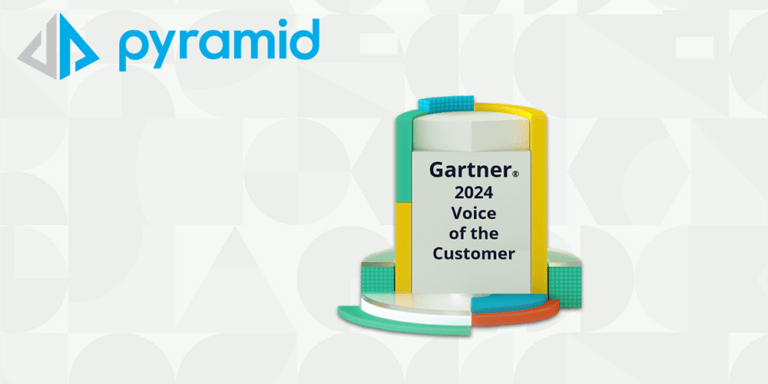This week, we’re thrilled to announce the release of Pyramid 2025 Newton, the latest evolution of Pyramid’s business analytics platform, with no less than 71 new features. This landmark release reflects our unwavering commitment to delivering a powerful, user-centric analytics platform that redefines how organizations harness data for smarter and faster decision-making.
With Newton, we’re not just releasing an upgrade, we’re rolling out a vision of the future of analytics. A future that’s more embedded, intuitive, and intelligent. The 2025 release is packed with enhancements focused on usability, scalability, and augmented capabilities, many of which originated from feedback from our user community.
Here’s a deep dive into what’s new, why it matters, and how it benefits organizations.
Reimagining embedded analytics
In today’s digital landscape, analytics can no longer be siloed. Organizations expect insights to be available directly within their workflows, applications, and tools of choice.
With Pyramid 2025, the embedded analytics capabilities take a leap forward with three major advancements.
Embedded search bar
One of the most exciting additions is the embedded search bar within the User Hub. This feature empowers users to ask questions in their own words, making it easier to explore data without needing advanced data science or business intelligence knowledge.
Whether you’re asking about sales trends, forecasting performance, or tracking KPIs, the platform understands your intent and returns relevant visualizations on the spot. Users can now save, categorize, and organize their generated content right from the Hub.
This functionality transforms the User Hub into a proactive decision support system, guiding users toward the insights that matter, exactly when and where they need them.
In short, Newton brings the power of analytics directly to the business user, removing friction and enabling insights at the point of impact.
Database Xtender
With this feature, supporting multi-tenant architectures is made easier and more flexible. The platform now allows organizations to connect to separate database servers, individual databases, or both, all from a single shared semantic model. This means you can deliver common content, like dashboards, analytic queries, calculations, and publications, while automatically swapping in the appropriate data source for each tenant behind the scenes. This translates to faster development, simplified maintenance, and a powerful foundation for scalable, multi-tenant deployments.
Enhanced formatting
Expanded formatting flexibility for embedded content gives you greater control over how analytics blend into your existing applications and website. You can now more precisely align the color schemes, general look and feel, and font styles of embedded visuals to match the design language of your host environment, delivering a more polished and cohesive user experience to your customers and internal business users.
More control and better customization for OEMs and enterprises
These new embedded features can be a game-changer for OEM partners and enterprise customers.
Teams can seamlessly integrate Pyramid into proprietary workflows, white-labeled portals, or customer-facing applications. This flexibility makes the Newton release especially impactful to organizations seeking a scalable, multi-tenant analytics engine without the burden of building one from scratch.
A community-driven journey
What makes Pyramid 2025 special isn’t just the tech, it’s the community behind it. From analysts and data scientists to developers and decision-makers, our users have played an instrumental role in shaping this release.
We are incredibly grateful for the feedback, feature requests, and conversations that helped guide our roadmap. Over the past year, we’ve gathered feedback from across our global community, identifying patterns and priorities to ensure we’re building a platform that truly meets your needs.
From UX improvements to performance enhancements, Newton introduces dozens of refinements, nearly 80% of them directly requested by users and all designed to make your experience smoother and more productive. These include:
Tabulate as a data source
Pyramid 2025 introduces the ability to use Tabulate, Pyramid’s built-in spreadsheet interface, as a data source for model building. This opens up exciting new possibilities, allowing users to leverage familiar spreadsheet functions—including cross-calculations between unrelated data sources—to create flexible, user-defined datasets that feed directly into the analytics pipeline. This is a powerful way to bridge spreadsheet-style agility with enterprise-grade analytics.
Dynamic queries in Tabulate
In another major upgrade, Discover queries in Pyramid can now remain dynamic within a Tabulate sheet. This enhancement increases the flexibility of spreadsheet-based solutions and opens up new possibilities for delivering analytic applications.
Data flow LLM switch
Building on our robust integration with leading large language models (LLMs), Pyramid 2025 lets users choose their preferred LLM within a data flow block. Whether you’re using generative AI for data classification, enrichment, or transformation, this new feature ensures greater control and adaptability, so you can select the model that best fits your use case or compliance needs.
Layered maps
Geospatial visualization gets a major upgrade in Newton with the introduction of layered maps. Users can now create multi-layered geographic insights, for example, shading regions by performance while simultaneously overlaying precise coordinate point data. This layered approach makes it easier to convey complex spatial relationships and trends within a single, intuitive visual.
Data lasso tool
Interaction with geospatial and scatter visuals becomes even more hands-on thanks to the new data lasso tool. Available on both maps and point charts, this feature allows users to draw a freeform shape to select and explore multiple data points at once. Whether you’re drilling into outliers or isolating a region of interest, this intuitive tool enhances interactive data exploration.
Fairness analysis
As AI becomes a more integral part of the analytics workflow, it’s essential to ensure that output remains fair and unbiased. Pyramid 2025 introduces a new fairness analysis tool that helps identify potential bias in insights generated through LLM interactions. It’s part of our commitment to building responsible, transparent AI-powered analytics you can trust.
Query optimization for SAP BW and SQL
We’ve introduced advanced query optimization techniques specifically for SAP BW and SQL-based environments. These improvements reduce execution times and improve performance, particularly when working with large or complex datasets. Whether you’re running routine reports or ad hoc analysis, expect faster, more efficient querying.
Delayed slicer execution
To improve performance in dashboards and reports with multiple filters, Pyramid 2025 includes an option for delayed slicer execution. This allows users to configure all slicer inputs first, and only trigger the query once they’re ready, reducing unnecessary recalculations and speeding up the entire interaction experience.
Get started with Pyramid 2025
By focusing on both the power user and the casual consumer, we’ve ensured that Pyramid 2025 doesn’t just add new features—it raises the bar for usability across the board.
The Newton release is available now, and we invite you to experience it firsthand and explore the full release notes.
We’re excited to see how teams will use these new tools and features to unlock data, spot opportunities, and drive better business outcomes.







